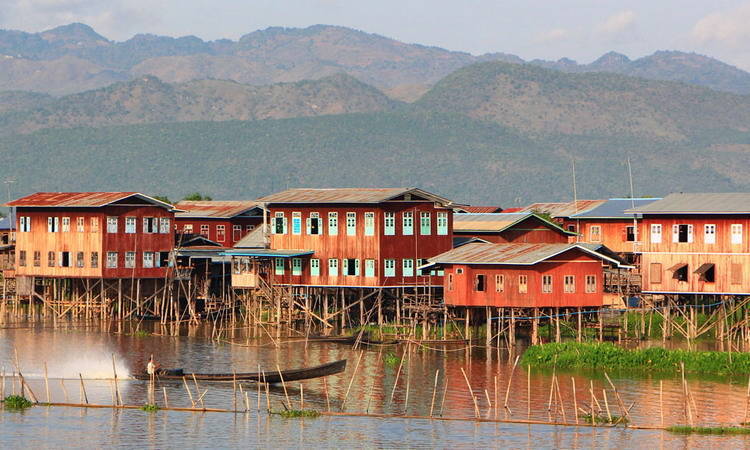INLE LAKE – BEST OF MYANMAR
In western Shan State, you will find picturesque Inle Lake, famous for its floating villages and gardens and the unique way of life of the local Intha people, with their living communities based entirely on the water. For practical information including restaurants, ATMs, accommodation and transport, visit our Nyaung Shwe page.
The lake, which measures 22 km long by 10 km wide, and sits in a valley between two mountain ranges, feels like a different world to the rest of Myanmar: in villages and towns across the lake, wooden houses are built on stilts and fishermen steer their one-man boats with a characteristic rowing style, wrapping one leg around their oar.

1. A brief history of Inle Lake
Along with fishing, traditional handicrafts are an important part of the local economy, and you will get to see silk weavers and silversmiths plying their trade on the lake. And as with all of Myanmar, religion plays a massive part in local life, and numerous pagodas and monasteries can be found on the lake and its shores. There also are many restaurants dotted around, where you can indulge in their delicious catches of the day.
Inle is one of Myanmar’s most popular destinations for travellers, so when you travel around the lake, part of what you see will inevitably be geared towards tourists. You may be taken to one too many handicraft workshops, as most guides get commission on sales, and negative examples of tourism development can be seen in everything from environmental degradation to the Kayan women found selling items in some village shops, wearing the traditional rings which elongate their necks; taking photos of them is encouraged, but the tribe is not in fact indigenous to this area – their own home is in the hills south west of Loikaw.
However, in many places the authentic life on the lake shines through, and it is so large – and the sites sufficiently spread out – that, outside of the villages and markets, it is always possible to find quiet, untouristy corners. Furthermore, steps are being taken to protect the area from man-made damage, including UNESCO designating Inle as a biosphere reserve.

2. Getting around Inle lake
Most boat trips around Inle Lake start at the town of Nyaung Shwe, a few kilometers to its north (where most budget and mid-range accommodation is found), although some people may base themselves at the hotels dotted around the lake’s shores (mostly luxury). There is a K12,500 entry fee for the Inle Lake area, which you pay when entering Nyaung Shwe.
The boarding area is located around the bridge at the western end of Yone Gyi Road in Nyaung Shwe, where local fishermen and guides compete for mooring space. From here, you will want to set off early in the morning for your trip around the lake.

There is a lot to see on Inle Lake and in the villages that surround it, so, unless you stay in the area for three days or more, you will need to be selective about what you want to see and do. Boat drivers, who also act as tour guides, will advise you on many of the best sights on the lake and its shores, but highlights can be found listed below. You can hire a bicycle for around K1500 per day in Nyaung Shwe, allowing you to explore the beautiful scenery on the eastern side of the lake, including Maing Thauk and the Red Mountain Estate vineyard.

Check with your guide if you want to have a swim in the lake, because the water can be very shallow (in most parts around 1.5 to 3 metres) and pollution may be an issue at certain times of year. Remember to pack your sunscreen before a day on the lake, because between stops there is no shade out there.



